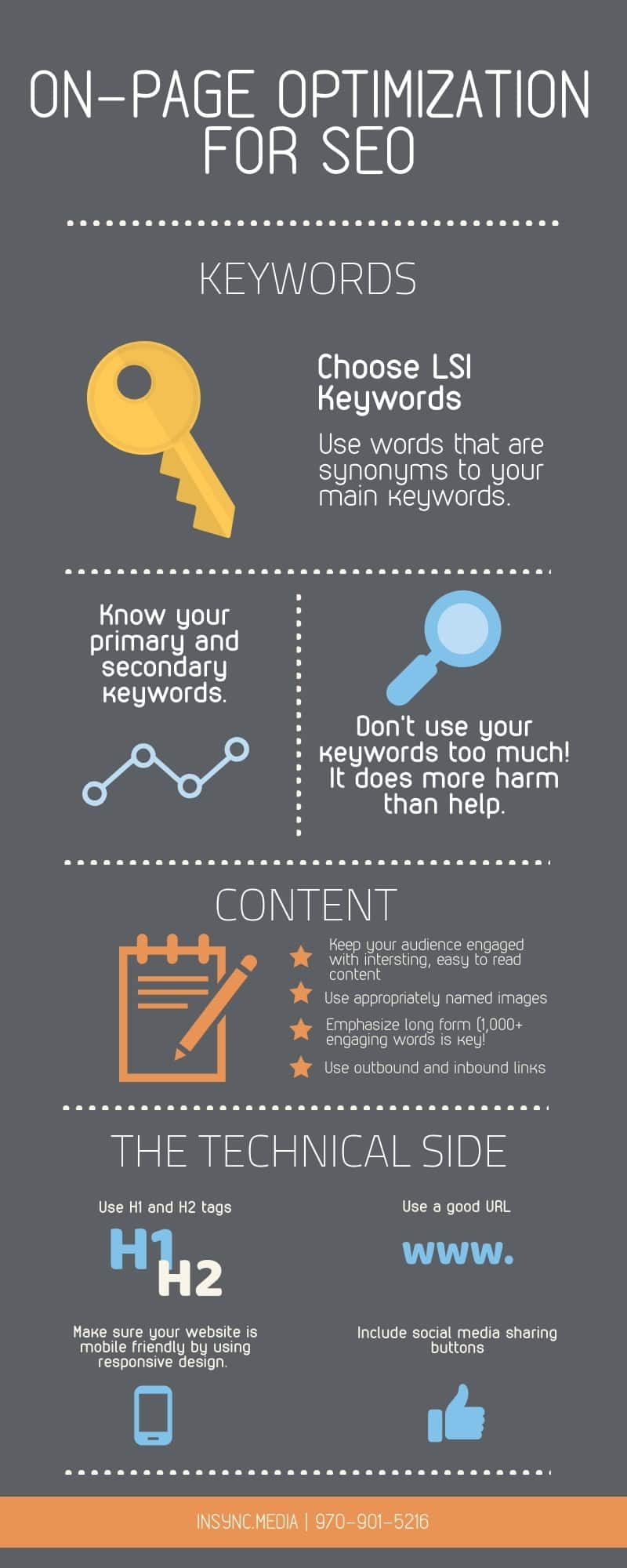You’ve probably heard about SEO. SEO, or Search Engine Optimization, is a frequently used phrase when developing any web content. That’s because this is a force behind a lot of what drives web-traffic.
On-page optimization involves what you can do to improve your SEO strategy and increase traffic to your website or blog. This includes the content and HTML source code of your page, meaning that there are certain elements you can include in your web content that will allow you to rank higher in search engines such as Google or Bing.
When you rank higher, then you will have more visitors and generate more leads for your business. Win!
Does SEO leave you scratching your head wondering how the H-DOUBLE-HOCKEY-STICKS you get your website to rank on Google?
Mastering the basics will allow you to increase traffic and gain regular visitors to your site. Successfully learning how to employ SEO does not have to be confusing.
Here is your guide to navigating the world of Web Search Optimization.
Your Complete Guide to On-Page SEO
How do I use keywords?
Often, when people think of on-page SEO, they immediately think of keywords. And that’s because keyword use and placement is an important part of your overall strategy. Keywords allow search engines to determine what it is you’re trying to say. Here are a few elements to think about when considering keyword use.
1. Know your primary and secondary keywords. The primary keywords are the main players, and secondary keywords are the support staff. They’re both important, but you will only have one primary keyword, and you can choose about four to ten secondary keywords. The primary search term is what you think people will look for when they seek out your site, and the secondary words are those that have fewer searches and carry slightly less weight in your content but remain important to the overall subject matter.
2. Choose some LSI Keywords. LSI is an acronym for Latent Semantic Indexing, which is a complicated way of saying that these are keywords that are in some way similar to the ones that you are using. So these are phrases or words that will be either synonymous or similar to your other keywords. Typically, you will sprinkle these naturally into your content. But if you want another way to gather these phrases, you can perform a google search using your keyword, scroll to the bottom of the page, and look at what is listed under “related searches.”
3. Use, but don’t abuse your keywords. Peppering your page with keywords won’t necessarily make your ranking higher. In fact, too high a concentration can instead make your rating lower. Use the words naturally and focus on the quality of the content.
4. Know when and where to position keywords. Start with your keyword in your title and then use it within the first 100 words.
What do I include in the content?

Just knowing about keywords is not enough to improve your SEO rating. While it is a crucial step towards increasing your traffic, the quality of your content and the way you format it on the page is equally as important.
1. Keep your audience engaged. Maintaining the attention of visitors to your site is important because if people immediately hit that back button, your ratings will be damaged. You can do this by incorporating attractive graphics, attention-grabbing imagery, or shareable video content.
2. Use appropriately named images. Using attractive visuals is excellent for keeping people on your site, and naming the files with an accurate title is a great way to get people there. If you name your image files using your keywords, then your images are more likely to show up in a search. This is a fantastic way to increase traffic to your site.
3. Emphasize long form. If you have at least 1,000 words of engaging, high-quality content, then users are more likely to stay on your page for longer. This, in turn, raises your SEO rating and you will increase traffic to your site.
4. Create aesthetically pleasing, easy-to-read content. Creating a site that is clean and easy to navigate means that people will then spend more time on your site and you will gain more legitimacy.
5. Validate your content with outbound links. Backing your material with reputable sources is a great way to boost your SEO rating and to validate your information. Outbound links help Google to determine what authority your site has on a topic by analyzing the materials with which you associate. Don’t overdo it though. Only choose quality links that are genuinely relevant to your content.
6. Use inbound links. Inbound links, or linking to other content on your domain, is another excellent way to boost relevancy and increase clicks and traffic to your site. This is an off-page SEO technique.
7. Make sure your content is good. With all of this talk about what to do to your content, it’s important to mention it should also be of a high-quality. While having valuable, relevant content is improved by knowledge of SEO, quality writing is crucial. If people bookmark or return to your page, this helps with search ratings too. They won’t do that if your content is mediocre. As with all things, grammar and spelling count, even with search engines, it is imperative to do adequate proofing of all content for errors.
How do I handle the technical side of On-Page SEO?
Now that we’ve talked about keywords and content, it’s time to discuss some of the smaller, technical aspects that will boost traffic to your site.
 1. Use h1 and h2 tags. While some blogs and websites do this automatically, placing the h1 tags (like this:<h1>Title</h1>) around your primary heading will allow readers to determine what your post is about. The h2 tags are placed around your subheadings to guide readers to the specific, most relevant parts of the article. Search engines use these markings to identify the top subjects within the content.
1. Use h1 and h2 tags. While some blogs and websites do this automatically, placing the h1 tags (like this:<h1>Title</h1>) around your primary heading will allow readers to determine what your post is about. The h2 tags are placed around your subheadings to guide readers to the specific, most relevant parts of the article. Search engines use these markings to identify the top subjects within the content.

2. Include social media sharing buttons. The easier it is to share, the more likely someone is to share it. The more people who share your content, the more people who get to see your site.

3. Make sure your website is mobile friendly by using responsive design. With the prominence of mobile browsing, making sure that your site is easily read and navigated on this platform is crucial to a good user experience. Additionally, Google penalizes sites that aren’t able to be read across multiple platforms.

4. Use a good URL. Make sure that your URL indicates what your page is going to tell the reader. This also means that you should put your keyword into the URL extensions, which can improve the search visibility of your site. It’s also helpful if your URL is not too long and that it is easy to read.
Here is On-Page SEO demystified for your benefit. If you employ these techniques, your site’s search engine visibility will improve, and therefore you will see an increase in people viewing your content. A great way to determine if you successfully utilized these tricks is to run an SEO analysis. An SEO check will give you a score and let you know what you can do differently to optimize your content. Soon, you will be a master of the art of on-site search optimization.

